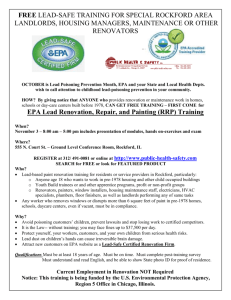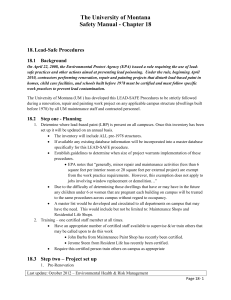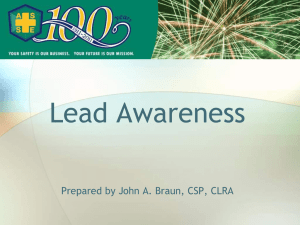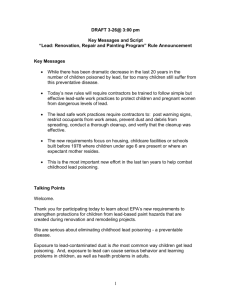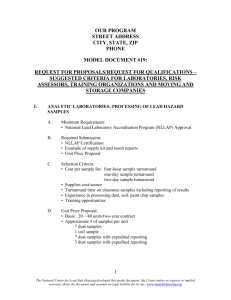Lead Paint Law Awareness Survey: Phone or E
advertisement
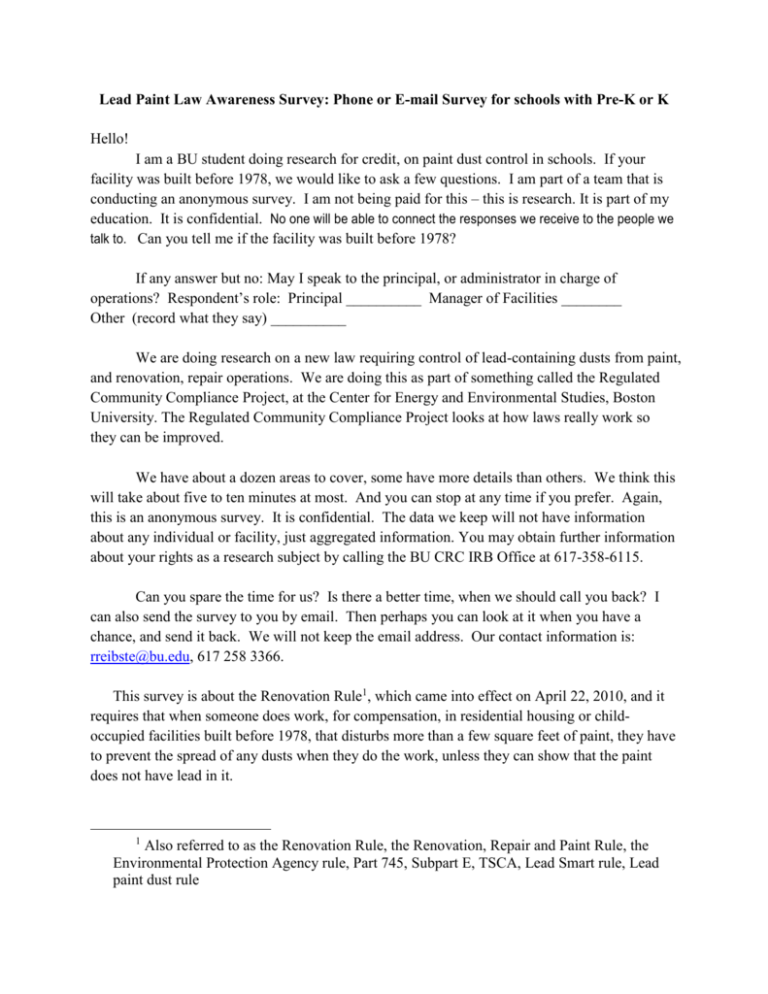
Lead Paint Law Awareness Survey: Phone or E-mail Survey for schools with Pre-K or K Hello! I am a BU student doing research for credit, on paint dust control in schools. If your facility was built before 1978, we would like to ask a few questions. I am part of a team that is conducting an anonymous survey. I am not being paid for this – this is research. It is part of my education. It is confidential. No one will be able to connect the responses we receive to the people we talk to. Can you tell me if the facility was built before 1978? If any answer but no: May I speak to the principal, or administrator in charge of operations? Respondent’s role: Principal __________ Manager of Facilities ________ Other (record what they say) __________ We are doing research on a new law requiring control of lead-containing dusts from paint, and renovation, repair operations. We are doing this as part of something called the Regulated Community Compliance Project, at the Center for Energy and Environmental Studies, Boston University. The Regulated Community Compliance Project looks at how laws really work so they can be improved. We have about a dozen areas to cover, some have more details than others. We think this will take about five to ten minutes at most. And you can stop at any time if you prefer. Again, this is an anonymous survey. It is confidential. The data we keep will not have information about any individual or facility, just aggregated information. You may obtain further information about your rights as a research subject by calling the BU CRC IRB Office at 617-358-6115. Can you spare the time for us? Is there a better time, when we should call you back? I can also send the survey to you by email. Then perhaps you can look at it when you have a chance, and send it back. We will not keep the email address. Our contact information is: rreibste@bu.edu, 617 258 3366. This survey is about the Renovation Rule1, which came into effect on April 22, 2010, and it requires that when someone does work, for compensation, in residential housing or childoccupied facilities built before 1978, that disturbs more than a few square feet of paint, they have to prevent the spread of any dusts when they do the work, unless they can show that the paint does not have lead in it. 1 Also referred to as the Renovation Rule, the Renovation, Repair and Paint Rule, the Environmental Protection Agency rule, Part 745, Subpart E, TSCA, Lead Smart rule, Lead paint dust rule 1. How do you the rank issue of preventing lead dust in terms of importance? Very Important Important Not Quite So Important 2. How would you assess your level of awareness of what is needed to prevent lead poisoning? Very High High Medium Needs Improvement 3. Have you, since April 22, 2010, had any work done that disturbs paint : 6 sq interior, 20 sq exterior? By disturb paint we mean sanding, scraping, just repainting over without that kind of preparation is not disturbing. NO__________ =>> 7 YES________ 4. Did you use a contractor who is certified by the EPA or State as performing the work in a lead-safe manner? YES______ Not SURE _____ NO ______ What is the reason if any that you did or did not? _______________ If they say Not Sure, ask if perhaps there is someone else who might be able to answer – because the rest of the questions are more details about the work. a. Did you do the work yourself, or was it done by someone who works for the organization? YES_____ Are you, or are they, certified and trained to perform the work in a lead-safe manner? YES ________ No_________ 5. Do you know if: Plastic was put up to contain dust in the area Yes____ No ____ I don’t know____ If yes – Was there complete enclosure of the work area? Yes____ No ____ Were objects removed or covered them? Were windows, vents, ducts, and doors kept closed or covered? 6. Do you know if they (whoever did the work): Provided the document Renovate Right to you before beginning? Yes ___ No ___ I don’t know____ Was the document made available to parents and guardians? Yes______ No_____I don’t know____ 7. Do you know if they: Put up a sign to prevent people from coming into the work area? Yes ____No___ I don’t know _____ Used a torch or flame? Yes ____No___ I don’t know ____ Used a power sander or blaster of water or pellets without containment? Yes____No___ I don’t know _______ Left the place clean? Yes ____No___ I don’t know _____ Did they provide you copies of their documentation of compliance? Yes _____ No ______ I don’t know _______ Do you know if they performed the cleaning verification? Yes ____No___ I don’t know ____ The cleaning verification is a process of making sure that the place is left clean, by wiping with dry and moist wipes, and comparing to a special card. Have you ever heard of that before?_____________ Did it cost more to have the work done by someone who complied with the law? YES- how much? No _______ I don’t know _________ 8. This law requires that the professionals who disturb paint in older homes or childoccupied facilities be trained and certified and do the work in a lead-safe manner. What is your opinion about this law? We have some suggested responses, or you can just tell us what you think. It is needed_________ It will do some good, but is a little burdensome __________ It is a waste of time and money __________ Other response _____________ 9. For any job that might cause dust, would you require contractors to contain the dust and leave the place clean? Yes ______ No _____ It depends ______ (on what?)________ 10. How do you the rank issue of preventing lead dust in terms of importance? Very Important Important Not Quite So Important 11. How would you rank the level of awareness at your facility about the specifics of this law? Again, this is a confidential survey and we ask you to tell us what you really think, and not have to worry about whether your answer will reflect badly on your management. Your response will not be traceable to your name. A score of one would be for a facility that was unaware of this law, and a score of ten would be for a facility that has ironclad assurances that it is followed very carefully. 12. What we learned when preparing to do this survey is that scientists don’t think there are really any safe levels of lead, and they have found very strong associations between lead and loss of IQ, impairment of brain development, and other harms. We also learned that in some places, lead dusts from disturbing paint is a leading cause of lead poisonings today, that it happens to people in all income levels, and that is quite easily preventable by taking steps to prevent the spreading of dusts, and by increasing awareness of the importance of cleaning them up. This is true also where paint is subject to weather or friction, such as windows. Is there anything that we talked about today, that has given you any ideas about anything you might now do? 13. We will publish the aggregated results of this survey as part of an effort to see how laws and their best functioning may be obtained, and we hope that policymakers will take note. Is there anything you would like to say, that might then be read by interested policymakers? 14. We have just two more questions. How many students are in your school? 15. Are there any children with elevated levels of lead, in your school? We do know of (a few, some, many)__________ We don’t know of any _________ 16. Do you have questions for us, about lead, or this law? ____________________________ We can send you information, including a copy of the report we write on this survey, if you would like. We will not keep a record of those facilities requesting information. To learn more about this law, go to www.epa.gov/lead. To find certified firms, go to www.epa.gov/lead, click on “Renovation, Repair, and Painting Program” on the right, and click “find certified repair and painting firms near you.” You can also find information on how to become lead-safe certified and take the training. Visit our website at http://www-test.bu.edu/rccp/ for with information about these laws, and also about the Regulated Community Compliance Project. You can also call the director of the project, our professor, at this number _______, or email him, if you have questions about the law.
